Background
The Sea Fury isn’t really all that well known. Timeline wise, it’s
sandwiched between the Hawker Tempest/Typhoon and the jet Sea
Hawk/Hunter. Yet it was one of fastest piston engined aircraft
produced.
The story of the Sea Fury starts in 1942, when Luftwaffe pilot
Oberleutnant Arnim Faber landed his Focke-Wulf Fw-190-A3 in the
UK accidently. The Royal Aircraft Establishment tested this
‘190’ and this influenced Specification F.6/42, for a high speed
fighter. The naval requirement was N.7/43. Hawker concentrated
on the land version (the Fury), whilst they contracted
Bolton-Paul to convert some into the carrier borne version.
6 prototypes were ordered – 2 were to have Rolls-Royce Griffon
85 engines, 2 Bristol Centaurus XXII’s, 1 with a Centaurus XII
and one as a static test. The Centaurus XII version was the
first to fly in September 1944, followed by the Griffons and the
first Sea Fury, powered by a Centaurus XV. Orders were placed,
with 200 land-based Fury’s and 200 Sea Fury's.
The end of the war in Europe effectively cancelled the Fury, but
the Sea Fury continued to be developed and entered service with
the Fleet Air Arm (Royal Naval Air Service) in spring 1947 as
the F.10. The reason why they didn’t start at F.1 was because
the RAF versions would have been F.1-9.
 |
The next version was the FB.11 featured here. This added the ground attack capability and was the most produced version, with 615 aircraft being built. It had a slightly more powerful Centaurus engine, provisions for up to 6 rockets, 2 drop tanks and RATOG (Rocket Assisted Take Off Gear, also know as JATO - Jet Assisted Take Off) gear.
It was a FB.11 that scored a memorable kill in Korea. On August 8, 1952, whilst operating off HMS Ocean, WJ232 shot down a North Korean MiG-15. Lieutenant Peter ‘Hoagy’ Carmichael became the only British pilot to score a ‘kill’ in a British aircraft during the war. The Sea Fury's superior maneuverability proved useful when they were pounced upon by MiG’s.
Export versions were also built. The Pakistani Air Force, the Egyptian Air Force, the Burmese Air Force, the Iraqi Air Force and the newly forced Luftwaffe Kreigsmarine all ordered new airframes. Fokker built license versions for the Royal Netherlands Air Force/Navy.
The Cuban Air Force also took delivery of 6 de-navalised Sea Furies. They were used against US forces in the Bay of Pigs invasion, and were successful in shooting down a number of B-26 Invaders.
The T.20 version was a trainer version of the Sea Fury. It had two seats and was later used by the Luftwaffe as a target tug, being re-designated the TT.20. The T.20’s were mainly used for conversion training but could be called upon in emergencies. They only had 2x20mm cannon, compared to the 4x20mm of the single-seat version.
 |
The end for the British Sea Fury's came in 1955, when the Sea Hawk replaced them as the principal single-seat aircraft for the Navy. The Burmese aircraft soldiered on until 1966.
The end didn’t really mean the end of the Furies. Several have been re-engined with Wright Cyclone engines for used in the Reno Air Races and have been reasonably successful over the year. The Royal Navy Historic Flight operates a FB.11, whilst a number of TT.20’s survive in preservation. Approximately 15 Sea Furies are still airworthy. 34 still exist around the world.
For more information, please visit - http://www.unlimitedair.com/Hawker_Sea_Fury_History.htm
Downloading and Installing
I received the review copy by download. It’s a 41.7mb download, and it is easy to install. The manual automatically pops out at the end of the installation process. The manual is a ‘must read’ to get the most out of the package. It explains how to arm the aircraft, how to fire the RATOG and the weapons and the supercharger controls.
What you get
Hawker Sea Fury FB.11 – Royal Navy 802 NAS of HMS Ocean
Royal Navy 799 NAS of RNAS Yeovilton
Royal Netherlands Navy 860 NAS of RNlNAS Valkenburg
Royal Canadian Navy 870 NAS of HMCS Magnificent
Hawker Fury FB.11 – Iraqi Air Force 7 Sqn
You also get a 17 page manual, explaining the various supercharger controls etc. To any of these aircraft you can fit rockets (60lb), bombs (500lb) and/or RATOG gear.
Visual of what you get:
 |
Flying Stations have done a good job in representing the Sea Fury’s rather big lines. She’s a big beast, but carefully modelled with a few little ‘surprises’ hidden inside.
Starting at the nose, the big propeller is well modelled, with it moving in time with moving the propeller control in the cockpit. The engine area is well done, with a bit of weathering around the exhaust and where the Coffman starter motor is.
 |
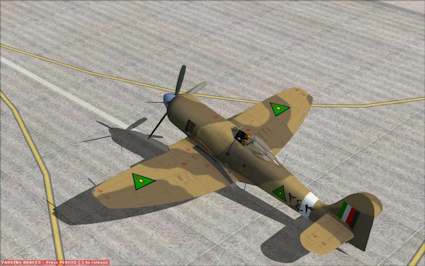 |
 |
 |
Speaking of the Coffman motor, I must mention the effect that is commendable by Flying Stations. When you start the engine, you use a cartridge to push the pistons over to speed up engine start. The Sea Fury model here has an effect that creates plumes of smoke on engine start.
All the normal moving parts are present and modelled. The canopy moves back, and with the parking brake on an additional step appears (in addition to the built-in steps). The tail hook moves smoothly and traps arresting wires well (providing you do a 3 point landing). The wings fold and expose the mechanism of the wing fold.
The general shape of the aircraft compares well with published photographs. The wings are accurate.
With the parking brake on, you can arm the aircraft. By pressing Shift+1, a small pop up window opens with load out options, activated by the up/down arrows. There is the choice of 2, 4 or 6 60lb rockets, or 2x 500lb bombs, with drop tanks and/or RATOG gear. All these are either fireable or jettison-able via arming controls in the cockpit.
 |
 |
 |
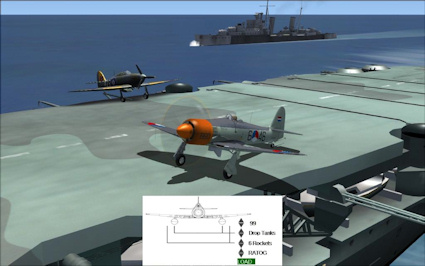 |
The RATOG gear fires via a master switch, then Joystick 1. They make a satisfying noise and lots of smoke comes out of the back of the pack for all 15 seconds of firing. They are jettisoned by using the ‘RATOG Jettison’ button and make a splash as they hit the water. The same kind of effects are present on the rockets and bombs, both splashing down, along with the drop tanks.
Interior
The first impressions of the cockpit are good. Whilst the instrumentation is quite basic, everything is there and correct. Very few photos are available of an ‘in service’ Sea Fury, but Flying Stations have stated that it was made from Pilot’s Notes and the Royal Navy Historic Flight (RNHF) example.
The ‘blind six’ are accurately implemented, but with the addition of two pop-up 2D panels – the default autopilot and the default GPS, for long range flights. Everything fluidly moves around the place.
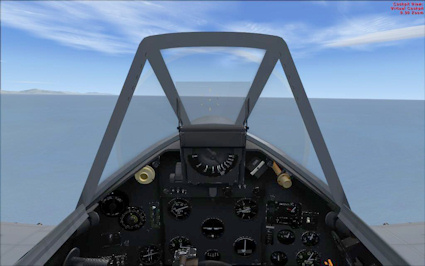 |
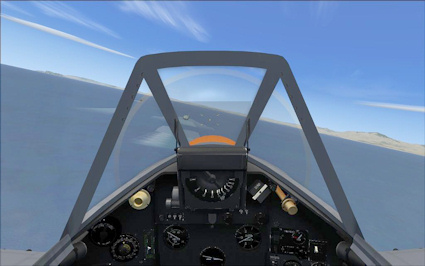 |
To the right are engine rpm, boost and temperature gauges. Further down the right hand side is the engine starter and primer switches, hidden behind flip-up protection shrouds. The engine start flips the other way to the primers – a useful safety feature.
On the left hand side sidewall, there is the armament arm/disarmed switches, RATOG switches, jettison switches, throttle, supercharger, RPM lever and the tail hook lever. It is clear that some reading of the manual is required.
 |
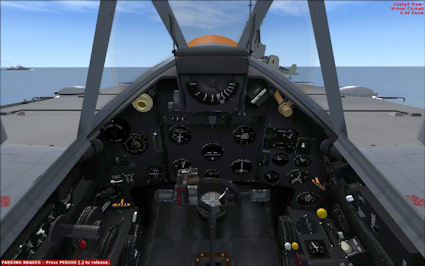 |
Once the manual is read, everything falls into place. The supercharger has two positions – ‘M’ and ‘S’. ‘M’ is for anywhere between 0ft-7500ft, with ‘S’ above that. If you’re wondering about the cowl flaps, they have two positions – open or closed, hence no gauge is provided.
A number of useful pre-set views exist. They enable easier access to the various switches on the side panels and an easier view of the landing. This is especially useful for carrier landings, where a three point landing is required for the hook to catch the arrestor wires.
The stick is well modelled, but the trigger doesn’t work in the clickable sense. Due to the mapping, the trigger is used either by Ctrl+Shift+M or the trigger on your joystick, which is logical actually.
 |
 |
Night lighting is next to non existent, with most of the lighting being directed at the instruments and/or radiating from them. The gunsight has a day/night switch, which makes the sight darker when in ‘night’ mode.
Sounds
Generally, the sounds are excellent. The quiet rumble of the engine whilst it is idling is great, whilst the full power scream is well executed. The engine notes do change in relation to throttle. The supercharger doesn’t seem to make a change, but as far as I can tell, this is realistic
The ‘piece de resistance’ is really the Coffman starter motor. The bang is startling if you’re not prepared for it. The associated plumes of smoke are well modelled as well. It masks the traditional ‘engine start’ sounds. Unfortunately, everything isn’t well at the other end. There is no engine stop sound – from running to silent. I contacted Flying Stations about this and they said it was an oversight, with the sound already edited etc. and will be released as a ‘service pack’.
Flight Dynamics
The Sea Fury, according to Eric ‘Winkle’ Brown, was described as ‘an excellent fighter, perfect for use in Korea.’ It is clear from the modelling that Flying Stations have paid close attention to the flight dynamics.
The vicious swing on take off is neatly executed, along with the reasonably high rate of roll and control harmony is well done. The engine provides plenty of power, whilst the airframe is reasonably smooth. The addition of weapons and drop tanks appear to make no difference to the handling.
Flight
For a carrier based aircraft, the only way to really test it is to go to sea. To do this, we’ll take off from the land, go to an aircraft carrier 10nm from the coast, land, takeoff using the RATOG gear and land on the hard ground.
Start up is easy, following the simple, ‘Prime cylinders, prime the injectors, pop the cartridge, mixture full, cowl flaps open and start’ procedure. Warm up takes only a few minutes at 1200 rpm, until the C.H.T. is ~120°C and >15°C oil temperature.
Magneto and supercharger checks done, time to go. It is strongly advised to gently open the throttle, as the engine does kick you to the right. Take-off from land is conducted with the tail wheel locked.
 |
 |
Once off the ground, raise the gear and the flaps if necessary. In this case, from an airfield, it isn’t, as specified in the manual. The canopy is closed smoothly and climbing away in ‘RPM AUTO’ mode. This ensures that the engine runs at the correct RPM compared to the boost level.
 |
 |
General manoeuvres are easy to do, with a reasonably high rate of roll. Loops and dives are very easy to do – and she’s a stable platform for weapons. The fireable weapons are aimed by the aforementioned gun sight. The thrill of letting a few rockets loose is excellent!
 |
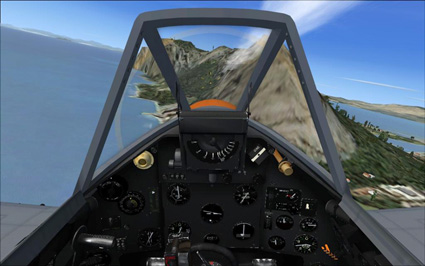 |
Time to land I think. Breaking into the circuit to land, we lower the hook. The carrier I’ve used for these shots is another Flying Stations product, namely their 1944 HMS Victorious, with free repaints from FlightSim.com. The hook makes no difference to trim etc.
 |
As we pull past the carrier, select ‘RPM Full’ and the first stage of flap is lowered, with nose down trim change. For carrier landings, the tail wheel is unlocked. Gear down causes nose up trim change.
As the engine creates so much torque, care is needed, especially if you miss a wire. Approach is conducted at high engine power at 145kts, with a round-down speed of about 120kts, landing at below 115kts.
Full flaps are deployed for the landing and as we settle down to land on the carrier. Final checks are completed and the touch-down needs to be a reasonable ‘three pointer’ for the hook to catch on the wire.
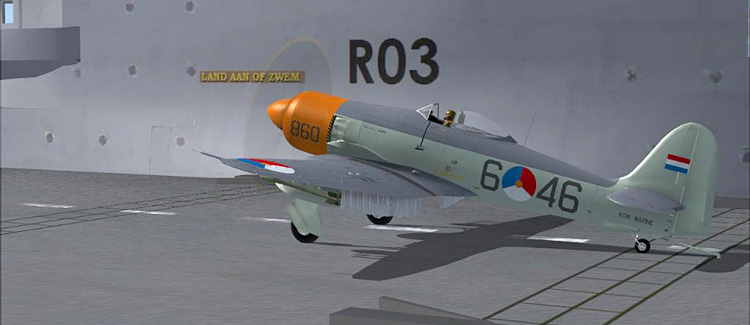 |
Once down, you’ll be able to tell in a few seconds whether you have caught a wire. Whilst doing this, I missed twice, and can tell from personal experience that a go-around needs a mix of power and left rudder/aileron to clear the deck. If you are used to the more forgiving FSX Acceleration F/A-18, you definitely need to practise three pointers!
The tail hook is released from the wire and we trundle back to the aft deck elevator. To do a RATOG take-off, we need to set the parking brakes, press ‘Shift+1’ to open up the load-out panel and select ‘RATOG’.
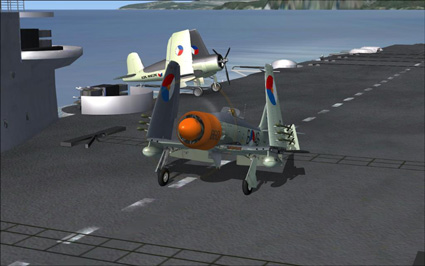 |
 |
To arm it (and give you a 45kt boost), first make sure the brakes are off. Then make sure the ‘Master Weapon Arm’ is in safe mode. Finally, arm the RATOG using the supplied switch. The trigger (in many cases also brakes) is used to set the pack off.
Make sure you are running straight and true, before advancing the throttle and pressing the trigger. You can hear and feel the force of the pack. Once airborne (and the pack has used up all the 6 seconds of energy), you can jettison the pack.
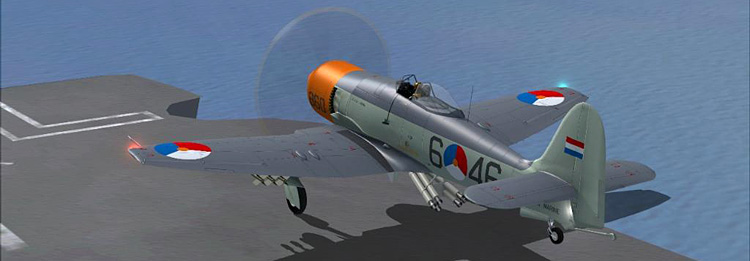 |
Landing on the land is very much like landing on the carrier, except that the tailwheel is locked and you don’t use the arrestor hook. For landings, the cowl flaps are closed. Luckily for land, you don’t have to do a three-pointer!
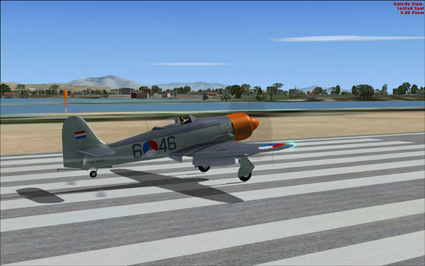 |
 |
Taxiing is easy and done through a mixture of rudder, engine power and differential braking. Engine shut-down is a simply matter of either pulling the magnetos or the mixture.
System Specs Required
● Internet connection (for download only)
● Microsoft Flight Simulator X Acceleration)
● 2.0 GHz or any Dual Core processor
● 2.0 GB of RAM
● 150 MB hard drive space
● 512 MB video card
Frames rates
(See my system spec Below)
● On the ground (ORBX freeware Cunderdin) – VC - 20fps
● Outside - 17fps
● On the carrier (AI Carriers) - VC - 15fps
● Outside – 16-18fps
● In Flight at 10000ft - VC 15-25fps
● Outside 15-20 fps
Note on frame rates – Whilst 10-20fps may sound slow, and it is, but the default Cessna 172 barely tops 20fps outside, and about 20-30fps in the VC. This is because my system isn’t great for FSX, but will still run it well.
Total flight time – 6.0 hours with 20+ carrier landings
Pros
● Good looks
● Great fun
● Unusual and interesting animations
Cons
● No engine shut down sound
● Can be a bit heavy on frame rates when using RATOG/starter
![]() Verdict
Verdict
For a small developer, Flying Stations have excelled themselves.
It is a superb aircraft to fly, and at the same time a challenge
to land on a carrier.
If you love big radials, three pointer
landings and carriers, this is the perfect aircraft for you. The
weapons are a nice ‘gimmick’ but don’t detract from the overall
quality. Apart from a few niggles, this is a good value, great
fun package.
I award this a Mutley's Hangar score of 8.5/10 well
done.
![]()
Kieran Marshall
Review machine Spec:
Intel Core2 6400 @2.13GHz | 2GB RAM |ATI Radeon X1300 |Windows
XP
